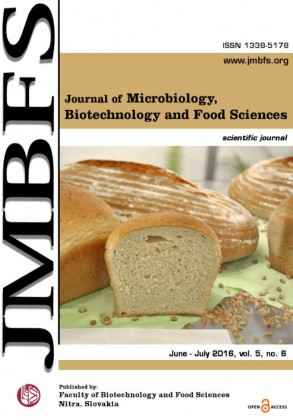AGROCHEMICALS AFFECT THE ANTIOXIDATIVE DEFENSE POTENTIAL of COTTON PLANTS
DOI:
https://doi.org/10.15414/jmbfs.2016.5.6.505-508Keywords:
Cotton plant, Insecticides, Peroxidase, Polyphenoloxidase, Proline, Methionine, CysteineAbstract
Application of insecticides used in cotton fields is often associated with secondary biotic stresses. One of possible reasons of such phenomenon is explained by decreased contents of plants’ defense components. As peroxidase (POD) and polyphenoloxidase (PPO) are typical oxidoreductase enzymes scavenging cell oxidative damage, we studied their change levels in cotton leaves in response to the application of three insecticides field experiment. Moreover, the concentration of proline (Pro), methionine (Met) and cysteine (Cys) was studied. The plants were treated with Carbophos, Lannate and Sumi-alfa in early blooming stage at commonly used doses in. Leaf samples were taken on the 10thand 13th days of the treatment. A pyrethroid insecticide Sumi-alfa appeared to negatively impact activities of both POD and PPO (P≤0.05), contrasting the other two insecticides examined. On the other hand, levels of amino acids with antioxidative properties increased after application of all three insecticides at the end of experiment. Our results show that the oxidative balance of treated plants was interrupted by insecticides (especially Sumi-alfa) with potential impact on vulnerability to secondary stresses. Effects of these insecticides on cotton should be considered and/or studied in more detail for efficient application in agriculture.Downloads
Download data is not yet available.
Downloads
Published
2016-06-01
How to Cite
Asrorov, A., Matušíková, I., Dalimova, S., Gálová, Z., Sultanova, E., Veshkurova, O., & Salikhov, S. (2016). AGROCHEMICALS AFFECT THE ANTIOXIDATIVE DEFENSE POTENTIAL of COTTON PLANTS. Journal of Microbiology, Biotechnology and Food Sciences, 5(6), 505–508. https://doi.org/10.15414/jmbfs.2016.5.6.505-508
Issue
Section
Biotechnology
License
Copyright (c) 2016 Akmal Asrorov, Ildikó MatuÅ¡Ãková, Surayyo Dalimova, Zdenka Gálová, Elvira Sultanova, Olga Veshkurova, Shavkat Salikhov

This work is licensed under a Creative Commons Attribution 4.0 International License.
All papers published in the Journal of Microbiology, Biotechnology and Food Sciences are published under a CC-BY licence (CC-BY 4.0). Published materials can be shared (copy and redistribute the material in any medium or format) and adapted (remix, transform, and build upon the material for any purpose, even commercially) with specifying the author(s).





